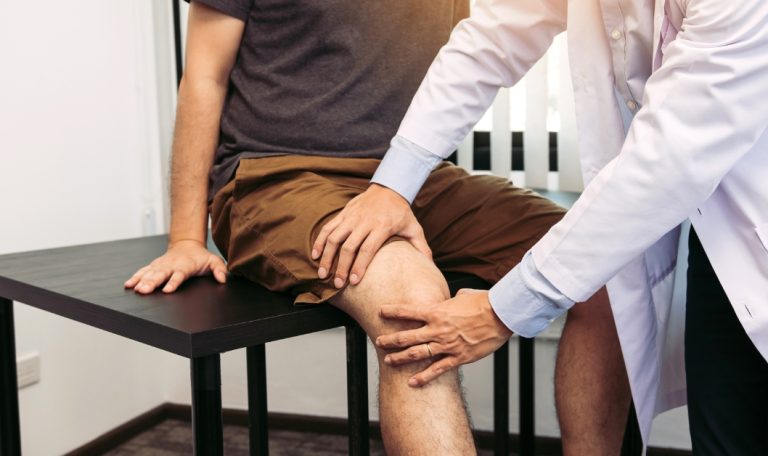Returning to Fitness After Knee Replacement: Safe Tips for an Active Life
Know the expert tips for safely returning to fitness after knee replacement with guidance from a top knee replacement surgeon.

Knee replacement surgery can offer a new lease of life for individuals suffering from chronic pain, stiffness, or mobility issues. Regaining strength, mobility, and confidence through a structured and safe return to fitness is just as important. The transition to an active lifestyle post-surgery must be approached with care, professional advice, and patience.
Understanding the Knee Replacement Recovery Journey
The success of a knee replacement lies in both the surgical procedure and the recovery strategy. Here's how the typical post-surgery recovery is staged:
- 0 to 2 Weeks (Immediate Post-Op Phase):Focus on managing pain, swelling, and wound care, often with limited mobility and assisted walking.
- 2 to 6 Weeks (Initial Rehabilitation):Patients start physiotherapy, basic leg movements, and light walking using support.
- 6 to 12 Weeks (Functional Recovery):Greater range of motion is achieved, and walking aids may be reduced.
- 3 to 6 Months (Strengthening Phase):Most individuals return to low-impact exercises and daily activities.
- 6+ Months (Long-Term Activity):Safe reintroduction of structured fitness routines and lifestyle activities.
Progress depends on factors like age, pre-surgery health, and adherence to rehabilitation plans. For personalised timelines, consultation with the best orthopedic surgeon in Ahmedabad ensures optimal recovery paths.

Consult Your Orthopaedic Specialist Before Starting
Before lacing up your trainers, always consult your physiotherapist orknee replacement surgeon in Ahmedabadto determine when and how to begin physical activity. Every patients recovery is different, and overexertion too early could result in complications or slowed healing. A tailored fitness programme, aligned with your personal health status, helps avoid unnecessary setbacks.
Why Fitness is Crucial After Knee Replacement
Staying active post-surgery is not just about aesthetics or regaining strength. Movement plays a vital role in:
- Preventing joint stiffness and enhancing flexibility
- Improving circulation and preventing blood clots
- Supporting weight management to reduce pressure on the new joint
- Strengthening muscles surrounding the knee for improved balance and gait
- Boosting mental health and overall well-being
Low-Impact Exercises That Are Safe and Effective
Here are some low-impact exercises that are generally considered safe from the third month post-surgery, subject to medical approval:
- Walking:Begin with short indoor walks, gradually increasing distance and time. Soft outdoor surfaces are preferable over concrete.
- Stationary Cycling:Ideal for building range of motion and endurance without stressing the knee joint.
- Swimming and Water Aerobics:Once the wound is healed, water-based exercises reduce joint impact while increasing flexibility and strength.
- Chair Exercises:Seated leg raises, heel slides, and knee extensions are great for strength building early on.
- Tai Chi or Gentle Yoga:Improve balance and flexibility without placing excessive strain on the knees.
Each of these should be performed at a comfortable pace, under supervision where possible, to ensure correct form and prevent strain.
Gradual Progression is Key
Progress should be measured in small, achievable goals. Follow these tips for a structured progression:
- Alternate exercise days with rest or stretching to avoid muscle fatigue
- Keep a journal to track pain, swelling, or any discomfort after each session
- Use pain and inflammation as feedback indicators to slow down or adjust routines
Overexertion can lead to setbacks such as joint swelling, fatigue, or even damage to the prosthesis. A cautious approach is always more sustainable.
Strength and Balance Training: Essential for Stability
Building muscle strength around the new knee is essential to regain function and avoid falls. Focus areas include:
- Quadriceps and Hamstrings:Leg lifts, straight leg raises, and mini-squats (within a safe range) strengthen the front and back of the thighs.
- Core and Back Muscles:Planks or gentle abdominal exercises help with posture and body control.
- Balance Exercises:Heel-to-toe walks, single-leg stands (with support), and stability ball work help reduce fall risk.
Balance exercises should only be attempted once a baseline level of strength and flexibility is restored. Consult your physiotherapist for safety guidelines.
Activities to Avoid After Knee Replacement Surgery
Returning to fitness does not mean all activities are suitable. Certain high-impact or twisting movements can jeopardise recovery:
- Running or Jogging:The impact may accelerate prosthetic wear or cause dislocation.
- Contact Sports (e.g. Football, Basketball):Risk of falling or collision is too high.
- High-Impact Aerobics:Jumping or bouncing activities may damage the replaced joint.
Instead, opt for controlled, low-impact alternatives that support longevity of the prosthesis.
Sample Weekly Fitness Routine After Knee Replacement (Post 3 Months)
Heres a safe and gradual 7-day plan you can follow after the initial recovery phase, with doctor approval:
|
Day |
Activity |
Duration |
|
Monday |
Walking at moderate pace + stretching |
30 minutes |
|
Tuesday |
Chair-based strength training exercises |
20 minutes |
|
Wednesday |
Rest or light stretching |
|
|
Thursday |
Stationary cycling |
1520 minutes |
|
Friday |
Swimming or water aerobics |
30 minutes |
|
Saturday |
Balance work (e.g., heel-to-toe walk) |
1015 minutes |
|
Sunday |
Rest or short walk |
1015 minutes |
Every individual recovers at a different pace. This plan should be adjusted based on comfort, endurance, and professional guidance.
Supportive Lifestyle and Nutrition Tips
Healing extends beyond physical activity. Your diet, habits, and sleep pattern play an important role in recovery:
- Eat an anti-inflammatory diet rich in leafy greens, berries, oily fish, nuts, and whole grains
- Ensure adequate protein intake to support muscle repair
- Consume calcium and vitamin D to strengthen bones around the joint
- Stay hydrated to maintain joint lubrication
- Avoid smoking and alcohol, which can slow down healing and increase infection risk
- Get 79 hours of sleep to allow your body to recover and rebuild
Such holistic care complements the advice from thebest orthopedic surgeon in Ahmedabad, improving your outcomes after surgery.
Warning Signs to Monitor During Recovery
Even with careful exercise, watch for these signs that may indicate a problem:
- Sudden or severe swelling around the knee
- Persistent or worsening pain not relieved by rest
- Clicking, locking, or instability in the joint
- Redness, warmth, or fever (possible infection)
- Difficulty bearing weight
If any of these symptoms occur, stop exercising immediately and consult your knee replacement surgeon in Ahmedabad.

Maintaining Motivation and Consistency
Recovery requires mental strength as much as physical. You can stay motivated by:
- Setting short, realistic goals and celebrating progress
- Using a journal or app to track daily achievements
- Listening to music or watching TV during indoor workouts
Conclusion
Returning to an active life after knee replacement surgery is entirely possible with the right guidance, patience, and discipline. By starting with low-impact activities, prioritising strength and balance, and progressing gradually, patients can safely regain mobility and confidence. Its essential to seek personalised advice from the best orthopedic surgeon in Ahmedabad and closely follow rehabilitation plans for lasting success.
If youre seeking expert care for joint health or knee replacement, Dr. Meet Mehta offers personalised orthopaedic solutions tailored to your fitness goals and recovery needs.


































